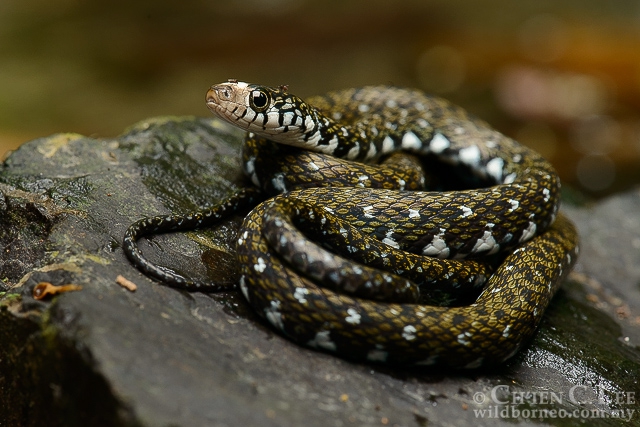| Citation |
|
Description |
Geographic Range [top]
Range Description: This species is endemic to the island of Borneo. Malkmus et al. (2002) list its range as Brunei, Sabah, and Sarawak. It has been found up to 1,300 m. asl.on Mt. Kinabalu and was thought to prefer habitat above 500 m. above sea level (Malkmus et al. 2002). However, the species is widespread in localities well below 500 m. asl.(R.F. Inger pers. comm.). In Kalimantan it is also easy to encounter at low altitudes.
Countries occurrence:
Native:
Brunei Darussalam; Indonesia (Kalimantan); Malaysia (Sabah, Sarawak)
Additional data:
? Lower elevation limit (metres): 50
? Upper elevation limit (metres): 1300
Range Map: Click here to open the map viewer and explore range.
Population [top]
Population: The species is one of the commonest snake species along streams. and populations seem to be stable. There are no species-specific population data available for this species. It is commonly found close to or inside clear water bodies, particularly streams in primary and tall secondary lowland forests (R.F. Inger pers. comm.). In Kalimantan the species is one of the most common along rivers streams and marshy areas.
Current Population Trend: Stable
Additional data:
? Population severely fragmented: No
Habitat and Ecology [top]
Habitat and Ecology: This species is found along small, clear, flowing waters in primary or tall secondary forests (Malkmus et al. 2002, R.F. Inger pers. comm.). Indeed, the genus shows a more or less strict preference for moist habitats in various freshwater bodies.
Systems: Freshwater
Use and Trade [top]
Use and Trade: There are no reports of this species being utilized or traded.
Threats [top]
Major Threat(s): Clearance of riverside forest is a potential threat to this species threatened by habitat loss and degradation across its range. While this species has a moderate distribution, its has only been found in clear streams in primary and mature secondary forests. R.F. Inger (pers. comm.) notes this species may be threatened by declines in water quality as a result of the ongoing deforestation, which causes siltation of streams. This causes a decline in tadpoles, a major component of this species diet (R.F. Inger pers. comm.).
Conservation Actions [top]
Conservation Actions: This species is known to occur in Kinabalu National Park (Malkmus et al. 2002), Crocker Range National Park (Das 2006). and Tawau Hills National Parks in Sabah (R.F. Inger pers. comm.). Gunung Gading National Park and Samunsam National Park in Sarawak and Temburong National Park in Brunei (I. Das pers. comm.). The species is present in Betung Kerihun national Park, Bukit-Baka-Bukit Raya National Park, Kayan Mentarang National Park and many other conservation are in Kalimantan (D. Iskandar pers. com.). There are no known species-specific conservation measures in place for this species. Further research into its abundance, range and habitat status is requires and monitoring should be conducted.
Citation: Inger, R.F., Iskandar, D. & Das, I. 2016. Hebius flavifrons. The IUCN Red List of Threatened Species 2016: e.T176333A96294516. http://dx.doi.org/10.2305/IUCN.UK.2016-1.RLTS.T176333A96294516.en. Downloaded on 21 July 2017.
Disclaimer: To make use of this information, please check the .
Feedback: If you see any errors or have any questions or suggestions on what is shown on this page, please provide us with feedback so that we can correct or extend the information provided
|

